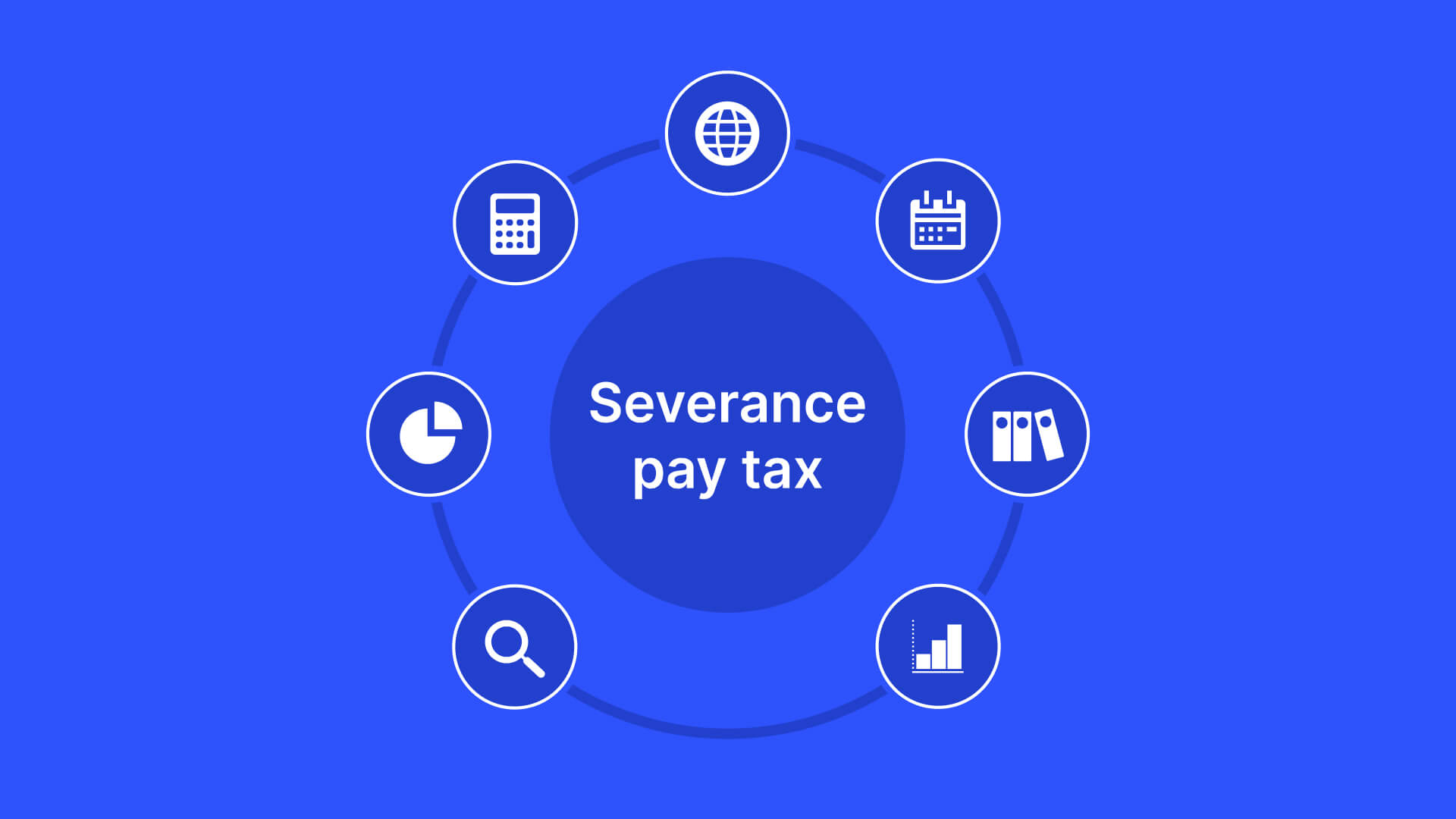Entrepreneurship is all about navigating diverse and often unpredictable circumstances while taking calculated risks. It’s not uncommon to encounter situations where tough decisions must be made, such as laying off employees or discontinuing roles due to financial restrictions. In such instances, it’s crucial to understand severance packages.
This can raise many questions for business owners, such as understanding severance pay tax. So it pays to be in the know. Read on for a comprehensive understanding of severance pay and its associated taxes.
Is severance pay taxable?
Yes, severance pay is taxable. Severance pay tax is subject to all the same taxes as regular wages, including federal income tax, Social Security and Medicare taxes. Additional taxes may also be applicable depending on whether the company offers benefits in addition to pay or if the employee faces COBRA fees for continuing health care coverage. Employers should withhold state and federal taxes from any severance payments to comply with their legal obligations.
Employers must provide a Form 1099-MISC if they are paying an individual more than $600 in severance or other forms of compensation. This form reports the total amount of taxable income received from them by the employee during that year.
Understanding taxation of severance pay
The taxation of severance pay is treated the same as regular income tax. This means it is subject to federal and state income taxes, Social Security tax, and the Medicare tax.
Federal severance pay tax implications:
According to the IRS, severance pay is considered supplemental wages subject to federal income tax. Employers typically withhold federal income tax at a flat rate of 22%. However, if your severance pay is combined with your regular wages, your employer might withhold taxes at your normal withholding rate.
Severance pay is also subject to Social Security and Medicare taxes. As of 2023, you pay the Social Security tax on income up to $147,000, and the rate is 6.2%. The Medicare tax is 1.45% on all wages, plus 0.9% tax on wages over $200,0002.
State severance pay tax implications:
State tax implications for severance pay can vary widely depending on where you live. Most states follow the federal guidelines and treat severance pay as taxable income. However, some states have different rules and may provide certain exemptions or deductions related to severance pay.
The advantages of top-notch global payroll services are within reach, wherever you are.
Severance pay tax rate
As mentioned, severance pay tax rate is calculated by the same rules as other forms of income. This means total annual income, including wages, salaries, and other forms of compensation.
Let’s give you a few examples.
Scenario A:
Let’s say you earn an annual salary of $60,000 and receive a severance package of $20,000. For the tax year, your total income will be $80,000. The federal tax on your salary will be calculated based on the tax brackets, while the $20,000 severance pay will have a flat 22% federal tax withheld, which equals $4,400.
Scenario B:
Things change a bit if you receive a substantial severance package, say $1.2 million. The first $1 million will be subject to a 22% federal tax ($220,000), and the remaining $200,000 will be taxed at 37%, which is $74,000. Your total severance package tax would be $294,000.
Remember, these scenarios only take into account federal taxes. State and local taxes will depend on your location and their specific regulations. Also, these examples don’t consider any severance pay deductions or tax credits you may qualify for, which could lower your overall tax liability.
Calculating severance pay tax rate
Has anyone invented a severance pay tax calculator yet? Hmm, we should patent that. Calculating severance pay tax involves several steps. Here’s a simple guide to help you understand the process:
Step 1: Understand Your Severance Pay
First, determine the total amount of your severance pay. This amount should be included in your severance agreement. It can consist of several components, such as pay for unused vacation or sick days, a lump-sum payment, or continued salary payments for a period of time.
Step 2: Determine the Federal Tax Rate
Severance pay is considered supplemental wages by the IRS. As mentioned above, the federal income tax withholding rate for supplemental wages under $1 million is typically 22%. If your severance pay is over $1 million, the excess incurs a 37% withholding rate.
Step 3: Calculate the Federal Tax
Multiply your severance pay by the appropriate federal tax rate to calculate the amount of federal tax. For example, if your severance pay is $30,000, you would multiply $30,000 by 22% (or 0.22), which equals $6,600.
Step 4: Calculate Social Security and Medicare Taxes
Remember, severance pay also incurs Social Security and Medicare taxes. As of 2023, the Social Security tax rate is 6.2% for incomes up to $147,000. The Medicare tax rate is 1.45% on all wages, with an additional 0.9% tax on wages over $200,0002.
Step 5: Determine State and Local Taxes
Most states tax severance pay as income, so you must determine your state’s tax rate. You can find this on your state’s Department of Revenue website. Some local municipalities also tax income, so you should consider this.
Step 6: Add Up Your Taxes
Once you’ve calculated each type of tax, add them together to find out the total amount of tax on your severance pay.
Remember, this is a general guide, and actual calculations can vary based on individual circumstances. Always consult with a tax professional for assistance with your personal tax situation.
Reporting and filing
The IRS considers severance pay taxable income and should be reported on your tax returns in the year you receive it. The process for reporting severance pay on your tax return generally involves the following steps:
Step 1: Receive a W-2 Form
Your employer should provide you with a W-2 form that includes your severance pay. This form reports your wages and taxes withheld for the year. Severance pay is typically included in Box 1 (wages, tips, other compensation), along with your regular wages.
Step 2: Report Your Income
When preparing your federal tax return, you’ll report the amount from Box 1 of your W-2 on your Form 1040. This will be included in the total wages you report.
Step 3: Calculate and Pay Any Additional Taxes
If insufficient taxes were withheld from your severance pay, you may owe additional taxes when you file your return. You’ll need to calculate your total tax liability based on your total income, which includes your severance pay. Then, subtract the total amount of tax that has already been withheld (which you can find on your W-2) to see if you owe additional money.
Step 4: State and Local Taxes
In addition to federal taxes, you may also need to report your severance pay on your state and local tax returns. This process varies depending on where you live, so it’s good to check with your state’s Department of Revenue or a tax professional.
Severance pay tax tips and best practices
Managing severance pay tax effectively is crucial to maximize your take-home amount and minimize tax liability. Here are some tips gathered from various tax professionals and financial advisors:
1. Understand Your Tax Obligations
Firstly, be aware that severance pay is considered taxable income. Federal taxes are typically withheld at a flat rate of 22% for supplemental wages like severance pay, but the actual tax you owe could be higher or lower depending on your total income for the year.
2. Consult a Tax Professional
Tax laws can be complex, and every individual’s situation is unique. Engage a tax professional to help you navigate through your specific circumstances. They can provide personalized advice and help you understand how your severance pay impacts your taxes.
3. Consider an Installment Agreement
If you owe a substantial amount in taxes and can’t afford to pay it all at once, an installment agreement can be a viable option. This allows you to pay off your tax debt over time.
4. Manage Your Income
If possible, consider spreading your severance pay over multiple years to avoid moving into a higher tax bracket in one year. Doing this can help you to reduce your tax bill and avoid a big tax bill in one year.
5. Manage Your Investments
If you have investments, consider managing your capital gains and losses. Selling investments at a loss can offset capital gains and reduce your taxable income.
6. Consider State Taxes
Don’t forget about state taxes. If you live in a state that taxes income, you’ll also need to pay state taxes on your severance pay.
Clear your Doubts with Multiplier
Understanding severance pay tax can be challenging for business owners and HR leaders. That’s where Multiplier’s leading EOR platform and our team of employment specialists come in. We simplify and streamline this and many other processes, ensuring a hassle-free and efficient experience. Want to know more? Talk to our experts and book a free demo.
Frequently asked questions
1. “Can severance pay be rolled over into an IRA?”
Severance pay can be rolled over into an Individual Retirement Account (IRA). However, it’s important to note that severance payments are generally treated the same as W-2 wages. This means they’re subject to income tax and cannot be directly converted to a retirement account.
2. “Are there state-specific tax considerations?”
There are state-specific tax considerations when it comes to severance pay. While the federal government taxes severance pay as regular income, the way states tax severance pay can vary.
3. “What percentage of severance pay is taxed?”
Severance pay tax is the same as regular income tax. The IRS treats severance pay as supplemental wages, meaning they are subject to income tax withholding. Employers typically apply a flat tax rate of 22% for supplemental wages, including severance pay.
4. “Do I need to pay Social Security and Medicare taxes on severance pay?”
You generally need to pay Social Security and Medicare taxes on severance pay. As of 2023, the Social Security tax rate is 6.2%, and the Medicare tax rate is 1.45%.
5. “Do different states have varying tax laws regarding severance pay?”
Different states have varying tax laws regarding severance pay. While all states must adhere to federal tax law, which treats severance pay as regular income subject to federal income tax, Social Security tax, and Medicare tax, state laws can vary.







